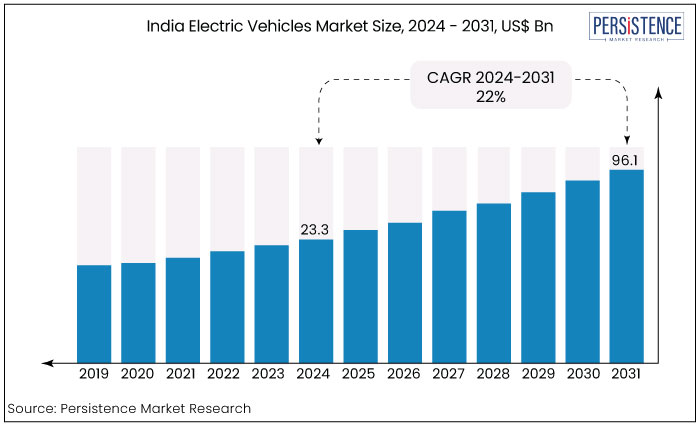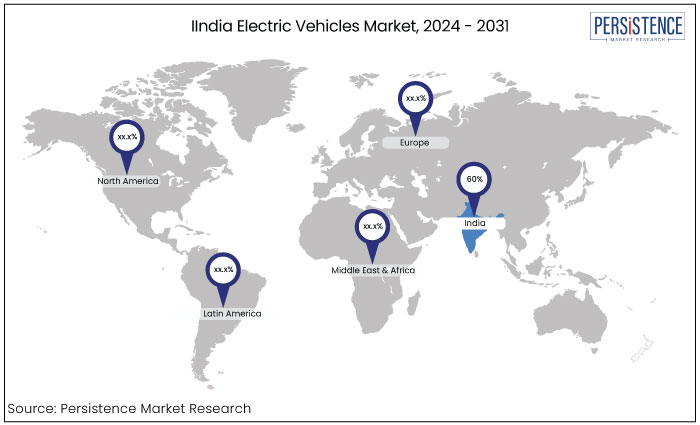Industry: Automotive & Transportation
Published Date: September-2024
Format: PPT*, PDF, EXCEL
Delivery Timelines: Contact Sales
Number of Pages: 178
Report ID: PMRREP20800
India electric vehicles market is estimated to increase from US$23.3 Bn in 2024 to US$96.1 Bn by 2031. The market is projected to record a remarkable CAGR of 22% during the forecast period from 2024 to 2031. The Indian government’s initiative to boost the electric vehicle sale and production is one of the key driving elements for the market over the forecast period. Uttar Pradesh is estimated to dominate the India electric vehicle market.

Key Highlights of the Market
|
Market Attributes |
Key Insights |
|
India Electric Vehicles Market Size (2024E) |
US$23.3 Bn |
|
Projected Market Value (2031F) |
US$96.1 Bn |
|
Global Market Growth Rate (CAGR 2024 to 2031) |
22% |
|
Historical Market Growth Rate (CAGR 2019 to 2023) |
15.6% |
|
Category |
Market Share in 2024 |
|
Vehicle Type - Passenger Cars |
60% |
Based on vehicle type, the India electric vehicles market is segmented into passenger cars and commercial vehicles. Among these, the passenger cars segment dominates the market and to account for 60% of the total market share.
Passenger vehicles to constitute 60% of the market share 2024. It is the market leader and the most rapidly expanding segment.
Passenger vehicles are increasingly sought after due to the diverse options, comfort, and elegance they offer, along with their low emissions in light of the rising trend in the purchase of passenger electric vehicles. For instance,
|
Category |
Market Share in 2024 |
|
Drive Type - Four Wheelers |
42% |
Based on drive type, the India electric vehicles market is divided into two wheelers, three wheelers and four wheelers. Among these, the four wheelers drive type segment dominates the market. The four-wheeler segment dominated the market in 2023 and is anticipated to lead during the projection period. It is anticipated to prevail throughout the forecast period, achieving the highest market share.
Urban commuters deem it cost-effective when evaluating the range in comparison to internal combustion engines (ICE). In comparison to two-wheelers, four-wheelers possess a great capacity for batteries leading to an extended range per charge. This renders the segment predominant relative to the other two parts.
Two-wheelers have considerable superiority over four-wheelers and represent the most rapidly expanding group. Two-wheelers are extensively utilized in India for transportation. The increasing traffic congestion on Indian highways is prompting the population to embrace micro-mobility for daily commuting and transportation. Furthermore, escalating gasoline prices and heightened knowledge and accessibility of electric two-wheelers are expected to expedite their adoption in the Indian market.
The rise in vehicle emissions in leading cities and the heightened awareness of the detrimental impacts of vehicular pollution on the environment and human health are propelling India electric vehicles market growth. The escalation of transportation fuel prices, including petrol, diesel, and CNG, is significantly propelling the adoption of electric vehicles in India.
The heightened procurement by global original equipment manufacturers (OEMs) from India and the growing inclination toward localization among leading OEMs is positioning the country as a favoured centre for design and manufacturing. The automotive sector in India greatly benefits from this trend receiving 8% of the nation's total research and development investment.
Electric vehicle market in India Uttar Pradesh, Delhi, and Karnataka have ranked as the leading three states for electric vehicle registrations in India. Over 870,000 electric vehicles have been registered in India, with Uttar Pradesh accounting for the huge number at over 255,000 units. Delhi possesses over 125,000 electric automobiles, while Karnataka has more than 72,500.
Among five states, Bihar has over 58,000 electric vehicles, and Maharashtra has over 52,500. Additionally, the Maharashtra state government offers an incentive of around USD 65 per kWh of battery capacity, along with exemptions from road tax and registration fees. The national government implemented measures to accelerate the use and production of hybrid and electric vehicles in India.
The national government has decreased the GST on electric vehicles from 12% and has also lowered the GST on charging infrastructure to encourage the establishment of electric vehicle charging stations. These reasons have significantly contributed to the expansion of electric car sales in India.

Pre-2023, the India electric vehicles (EV) market experienced steady growth largely driven by increasing environmental awareness, government incentives, and the rising need to reduce oil imports.
The government's FAME (Faster Adoption and Manufacturing of Hybrid and Electric Vehicles) schemes and state-level incentives played a crucial role in accelerating EV adoption. The development of EV charging infrastructure in leading cities also supported the market. However, high initial costs, limited charging infrastructure in rural areas, and range anxiety remained challenges that limited the wider adoption of EVs during this period.
Post-2024, the market is expected to grow significantly as India prioritizes clean energy and sustainable transportation. The government's aggressive plans to phase out conventional internal combustion engine vehicles and promote electric mobility are expected to drive a major shift towards EVs.
Advances in battery technology, cost reductions, and expanded charging networks will make EVs more accessible and affordable. The entry of global and domestic automakers into the Indian EV space, coupled with strategic partnerships in battery manufacturing, is set to fuel market expansion.
Government Policies and Incentives
The supportive government policies and incentives are one of the significant growth drivers for the India electric vehicles (EV) market. The Indian government has implemented schemes such as FAME (Faster
Adoption and Manufacturing of Hybrid and Electric Vehicles) and Production-Linked Incentive (PLI) programs that provide subsidies and financial support to both manufacturers and consumers. These incentives reduce the cost of EV ownership and encourage adoption.
Several state governments have introduced their own EV policies offering benefits like tax exemptions, registration fee waivers, and rebates. The government’s ambition to electrify a large portion of public transportation by 2030 including buses and three-wheelers is also expected to boost the EV market.
Continued policy support for battery manufacturing and efforts to improve charging infrastructure will drive the India electric vehicles market growth by making EVs more affordable and accessible.
Expansion of Charging Infrastructure
The expansion of EV charging infrastructure across India is a crucial driver for market growth. Previously, limited charging stations posed a significant challenge to the widespread adoption of electric vehicles, causing range anxiety among consumers. The government and private players are actively investing in building extensive charging networks especially in urban areas and along major highways.
Initiatives like the National Electric Mobility Mission Plan (NEMMP) and public-private partnerships have accelerated the installation of fast chargers, enabling more convenient EV use. Charging station availability at workplaces, residential complexes, and public spaces is expected to increase, reducing concerns over long-distance travel and daily commuting.
As charging networks expand, consumer confidence in EVs will rise, further boosting adoption across both commercial and private segments of the market.
Technological Advancements in Battery Technology
Technological advancements in battery technology represent another key growth driver for the Indian EV market. Lithium-ion batteries, which power most electric vehicles have seen rapid improvements in terms of energy density, cost, and charging time.
Battery prices have fallen significantly over the past few years, making electric vehicles more cost-competitive with traditional internal combustion engine vehicles. Innovations in solid-state batteries and other next-generation energy storage technologies promise even further improvements in range, charging speed, and longevity.
The Indian government’s push for domestic battery manufacturing through the PLI scheme will lower import dependency, reduce costs, and enhance the supply chain. As battery technology continues to improve, the performance and affordability of EVs will increase, making them a more attractive option for Indian consumers, further driving India electric vehicles market growth.
High Initial Cost of EVs
One of the key restraints for the electric vehicles (EV) market growth in India is the high upfront cost of EVs compared to traditional internal combustion engine (ICE) vehicles. Although the long-term operational costs of EVs are lower due to reduced fuel and maintenance expenses, the high initial purchase price remains a barrier for price-sensitive consumers.
The cost is largely driven by expensive battery technology, which accounts for a significant portion of the vehicle’s total cost. While government subsidies and incentives have helped reduce this gap, many consumers still view EVs as unaffordable.
The cost disparity is more pronounced in rural and semi-urban areas, where consumers are more likely to opt for cheaper, conventional vehicles. Until battery prices decrease further or subsidies increase, the high initial cost will continue to slow the mass adoption of EVs, particularly in lower-income segments.
Expansion of Charging Infrastructure
One of the main challenges for EV adoption in India has been the lack of widespread charging infrastructure. However, this is rapidly changing with efforts to develop EV charging stations in both urban and rural areas.
Private and public sector partnerships are emerging to install fast-charging networks especially along highways, key cities, and leading commercial hubs. It provides a significant opportunity for infrastructure companies, energy firms, and tech innovators to lead the market in setting up charging ecosystems and software solutions for EV management.
The Indian government is playing a pivotal role in boosting EV adoption through various incentives and regulatory frameworks. The fast adoption and manufacturing of hybrid and electric vehicles (FAME) schemes, both Phase I and Phase II, are key examples. These initiatives provide subsidies for electric two-wheelers, three-wheelers, and buses while promoting the development of charging infrastructure.
The focus on reducing import dependency on fossil fuels and curbing pollution aligns with India's larger sustainability goals. This creates a significant opportunity for manufacturers and suppliers in the EV supply chain from batteries to motors.
The competitive landscape of the India electric vehicles (EV) market is characterized by a mix of established automakers and emerging startups. Key players include Tata Motors, Mahindra Electric, and Hero Electric, which are leveraging strong brand recognition and extensive distribution networks.
International players like Tesla and BYD are also entering the market aiming to capture a share of the growing demand. Startups such as Ather Energy and Ola Electric are focusing on innovation particularly in smart features and sustainable practices.
The market is also witnessing increased investment in battery technology and charging infrastructure. Collaborations between automotive companies and tech firms are becoming common enhancing competitiveness and driving advancements in EV technology.
Recent Industry Developments in the India Electric Vehicles Market
|
Attributes |
Details |
|
Forecast Period |
2024 to 2031 |
|
Historical Data Available for |
2019 to 2023 |
|
Market Analysis |
US$ Billion for Value |
|
Key Market Segments Covered |
|
|
Key Companies Profiled in the Report |
|
|
Report Coverage |
|
|
Customization & Pricing |
Available upon request |
By Technology
By Vehicle Type
By Drive Type
To know more about delivery timeline for this report Contact Sales

The market is estimated to be valued at US$23.3 Bn in 2024
The market is estimated to exhibit a healthy CAGR of 22% over the forecast period.
A key opportunity lies in the expansion of charging infrastructure.
Some of the top players in the market are Ola Electric, TVs Motors, and Bajaj Auto Limited.
India electric vehicle market is estimated to reach US$96.1 Bn in 2031.